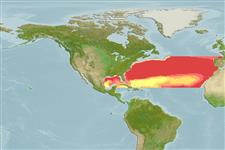>
Stomiiformes (Lightfishes and dragonfishes) >
Stomiidae (Barbeled dragonfishes) > Melanostomiinae
Etymology: Chirostomias: Greek, cheir = hand + Greek, stoma = mouth (Ref. 45335).
More on authors: Regan & Trewavas.
Environment: milieu / climate zone / depth range / distribution range
Ecologia
marino batipelagico; distribuzione batimetrica ? - 500 m (Ref. 5951). Deep-water; 45°N - 20°N
Eastern Atlantic: Spain south to Mauritania. Western Atlantic: USA to Cuba. Northwest Atlantic: Canada (Ref. 5951).
Size / Peso / Age
Maturity: Lm ? range ? - ? cm
Max length : 20.5 cm SL maschio/sesso non determinato; (Ref. 4468)
Short description
Chiavi di identificazione | Morfologia | Morfometria
Raggi dorsali molli (totale) : 18 - 20; Raggi anali molli: 22 - 26. Body slender, compressed, much deeper than wide. Barbel short. Stem of barbel black or dark brown, basal portion of bulb black, terminal luminous portion and filaments yellowish. Postorbital photophore absent in males, present in males. Black, with greenish or bluish bronze iridescence on anterior parts of sides (Ref. 37473).
Mesopelagic species.
Life cycle and mating behavior
Maturità | Riproduzione | Deposizione | Uova | Fecundity | Larve
Gibbs, R.H. and M.A. Barnett, 1990. Melanostomiidae. p. 308-337. In J.C. Quero, J.C. Hureau, C. Karrer, A. Post and L. Saldanha (eds.) Check-list of the fishes of the eastern tropical Atlantic (CLOFETA). JNICT, Lisbon; SEI, Paris; and UNESCO, Paris. Vol. 1. (Ref. 4468)
IUCN Red List Status (Ref. 130435: Version 2024-1)
Threat to humans
Harmless
Human uses
Strumenti
Special reports
Download XML
Fonti Internet
Estimates based on models
Preferred temperature (Ref.
123201): 11.5 - 19.3, mean 13.8 °C (based on 22 cells).
Phylogenetic diversity index (Ref.
82804): PD
50 = 1.0000 [Uniqueness, from 0.5 = low to 2.0 = high].
Bayesian length-weight: a=0.00302 (0.00116 - 0.00786), b=3.12 (2.89 - 3.35), in cm total length, based on LWR estimates for this (Sub)family-body shape (Ref.
93245).
Trophic level (Ref.
69278): 4.3 ±0.8 se; based on size and trophs of closest relatives
Resilienza (Ref.
120179): Medio, tempo minimo di raddoppiamento della popolazione 1.4 - 4.4 anni (Preliminary K or Fecundity.).
Fishing Vulnerability (Ref.
59153): Low vulnerability (15 of 100).
Nutrients (Ref.
124155): Calcium = 26 [6, 111] mg/100g; Iron = 0.425 [0.131, 1.408] mg/100g; Protein = 3.06 [0.00, 7.01] %; Omega3 = 0.172 [0.053, 0.606] g/100g; Selenium = 7.76 [1.93, 30.84] μg/100g; VitaminA = 59.7 [7.7, 460.7] μg/100g; Zinc = 0.52 [0.23, 1.28] mg/100g (wet weight);
